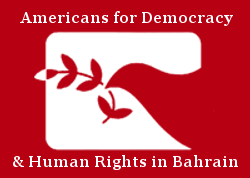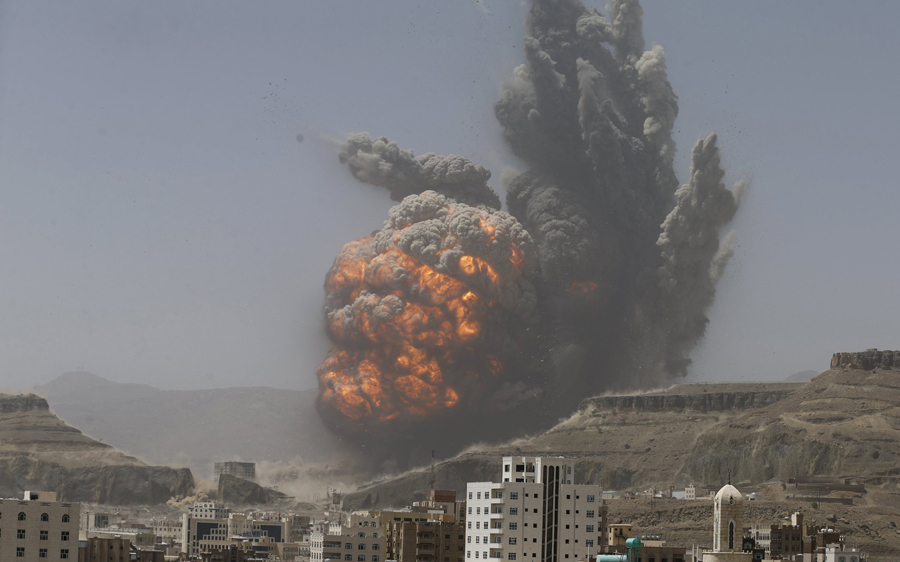Ahead of the 38th session of the United Nations (UN) Human Rights Council (HRC), Americans for Democracy & Human Rights in Bahrain (ADHRB) submitted a written statement to the UN HRC raising serious concerns about violations of international humanitarian law by Saudi Arabia and its coalition allies in Yemen. Read the statement below or click here for a PDF.
Americans for Democracy & Human Rights in Bahrain welcomes this opportunity at the 38th Session of the United Nations (UN) Human Rights Council to raise serious concerns about violations of international humanitarian law (IHL) by Saudi Arabia and its coalition allies in the conflict in Yemen. Since entering the war, Saudi Arabia and its coalition allies have launched thousands of airstrikes in Yemen, many of them targeting civilian-populated areas, while also enforcing a naval and aerial blockade of Yemen. The airstrikes and blockades have indiscriminately targeted non-combatants, in direct contravention of the principles of IHL.
Justification for Saudi Arabia’s Intervention
Saudi Arabia and its coalition allies entered the war in Yemen in March 2015 in an ostensible effort to support the legitimate government of Yemeni President Abd Rabbu Mansour Hadi citing United Nations Security Council (UNSC) resolutions 2140 and 2216 as the reason for their intervention. UNSC 2140 voices support for Hadi’s government and calls on all parties to reject violence and work constructively to aid a peaceful political transition.[1] UNSC 2216 demands that Houthi forces withdraw from “all areas seized during the latest conflict, relinquish arms seized from military and security institutions, cease all actions falling exclusively within the authority of the legitimate Government of Yemen and fully implement previous Council resolutions.”[2] Resolution 2216 is partially based on an official request submitted to the UNSC on 24 March 2015 by the Permanent Representative of Yemen to the UN, in which Hadi informs the President of the Security Council that “he has requested from the Cooperation Council for the Arab States of the Gulf and the League of Arab States to immediately provide support, by all necessary means and measures, including military intervention, to protect Yemen and its people from the continuing aggression by the Houthis.”
While Saudi Arabia and its coalition allies point to UNSC resolutions 2140 and 2216 as the basis for their armed intervention, neither resolution empowers the coalition to engage in indiscriminate attacks on civilian areas, or establish a crippling blockade of Yemen that disproportionately affects non-combatants.
Airstrikes
According to the Yemen Data Project, since Saudi Arabia and its coalition allies entered the conflict in Yemen, they have conducted over 16,000 airstrikes.[3] While many were military targets – Houthi training camps, positions of pro-Houthi fighters, military convoys, and weapons caches – many of the strikes targeted civilian areas. Among the civilian targets struck by airstrikes were refugee camps,[4] schools including a school for the blind,[5] markets, weddings,[6] and a funeral hall.[7] The coalition has also attacked hospitals around northern Yemen, including hospitals supported by Doctors without Borders (MSF). As a result of the attacks, and following the 15 August 2016 bombing of Abs Hospital in Yemen’s Hajjah governorate, MSF “withdrew its staff from Haydan, Razeh, Al Gamouri, and Yasnim hospitals in Saada governorate and Abs and Al Gamouri hospitals in Hajjah governorate.” According to MSF, the 15 August airstrike on Abs Hospital was the “fourth and deadliest attack on an MSF-supported medical facility during the war.”[8]
Among the thousands of airstrikes launched by the Saudi-led coalition, international human rights organizations Amnesty International and Human Rights Watch have identified and documented 19 airstrikes in which coalition fighter jets used internationally-banned, British- and Brazilian-manufactured BL755 cluster munitions.[9] Amnesty International found evidence of cluster munition use in farmland near the Saudi border, where two brothers found unexploded ordnance in April 2016 and brought them back to their village where one subsequently exploded.[10] Human Rights Watch documented a December 2016 airstrike where coalition jets dropped cluster bombs near “two local schools in northern Yemen, killing two civilians and wounding six, including a child,” as well as evidence of a February 2017 attack on a farm.[11]
Blockade
In addition to its campaign of airstrikes, the coalition has placed Yemen under a crippling naval and aerial blockade. This has had a devastating effect on the lives of millions of Yemenis, as the country imports 90 percent of its goods. The naval blockade has severely restricted the import of food, water, and fuel, while the aerial blockade on Sana’a’s airport has severely restricted the import of necessary medical as well as humanitarian supplies. As a result, Yemen has become one of the world’s worst man-made humanitarian crises, with the UN High Commissioner of Refugees warning that 22.2 million people are in need of aid while 2 million people are internally displaced,[12] with over 100,000 people displaced over the past six months alone.[13]
The humanitarian crisis has been exacerbated by a lack of adequate health facilities and infrastructure. According to the directors of the World Health Organization (WHO), World Food Programme, and UN Children’s Fund (UNICEF), “less than half of Yemen’s health facilities are fully functional.”[14] As a result, Yemenis are not only facing shortages of food, they are also facing disease outbreaks, including cholera, diphtheria, and malaria. Since April 2017, more than a million Yemenis have contracted cholera and more than 2,000 have died,[15] while the WHO states that since October 2017 a diphtheria outbreak has affected more than 1,300 people, 80 percent of who are children.[16]
International Humanitarian Law (IHL) Violations
IHL seeks to “limit the effects of armed conflict” and to protect persons “who are not or are no longer participating in the hostilities.”[17] As such, it seeks to protect civilians from the effects of conflict and calls on all sides of a conflict to protect non-combatants, including medical personnel, supplies, hospitals, and ambulances. Perhaps most importantly, IHL:
“Prohibits all means and methods of warfare which
- fail to discriminate between those taking part in the fighting and those, such as civilians, who are not, the purpose being to protect the civilian population, individual civilians and civilian property; [and]
- cause superfluous injury or unnecessary suffering.”
Saudi Arabia and its coalition allies’ conduct in the Yemen conflict does not effectively discriminate between fighters and civilians. Airstrikes have repeatedly struck civilian areas, killing hundreds of noncombatants as well as striking hospitals and medical facilities. Indeed, MSF judged the danger to their medical staff from coalition airstrikes to be so great they withdrew their staff from six northern hospitals in a near-unprecedented move. The coalition’s blockade also fails to discriminate between combatants and noncombatants. The restrictions on the import of food, medicine, fuel, and water is a form of collective punishment, affecting millions of civilians in an attempt to cripple the fighting capabilities of the Houthi rebels.
Conclusion and Recommendations
Saudi Arabia and its coalition allies’ actions in Yemen have led to one of the world’s worst man-made humanitarian crises. The combination of thousands of airstrikes on civilian targets and a naval and aerial blockade has brought the country to the brink of famine, with millions of civilians in need of aid, medicine, and food. The coalition’s indiscriminate methods stand in clear violation of the rules of IHL.
Saudi Arabia and its allies must:
- Ease the blockade to allow aid to flow freely to all areas of the country;
- Re-open Sana’a airport;
- Cooperate fully and transparently with UN-appointed Group of Eminent Experts;
- Halt all airstrikes until an international, independent, and impartial commission can investigate all allegations of attacks on civilians;
- Immediately halt all fighting to work towards a political settlement to end the conflict.
[1] United Nations Press, “Security Council Adopts Resolution 2140 (2014), Welcoming Yemen’s Peaceful Transition towards New Constitution, General Elections,” United Nations Security Council, SC/11296, 26 February 2014, https://www.un.org/press/en/2014/sc11296.doc.htm.
[2] United Nations Press, “Security Council Demands End to Yemen Violence, Adopting Resolution 2216 (2015), with Russian Federation Abstaining,” United Nations Security Council, SC/11859, 14 April 2015, https://www.un.org/press/en/2015/sc11859.doc.htm.
[3] Yemen Data Project dataset, last updated 12 March 2018, available at http://yemendataproject.org/data/.
[4] Kareem Shaheen, “Witness to air strike on Yemen refugee camp: women and children burned beyond recognition,” The Guardian, 31 March 2015, https://www.theguardian.com/world/2015/mar/31/yemen-in-crisis-air-strike-leaves-40-civilians-dead-at-camp.
[5] Alex MacDonald, “Yemen centre for blind ‘hit in Saudi coalition air raid,’” Middle East Eye, 5 January 2016, http://www.middleeasteye.net/news/saudi-led-coalition-airstrikes-reportedly-hit-centre-blind-yemen-capital-128298478.
[6] Ben Norton, “We must pay attention to Yemen: Weddings bombed, civilians killed – with U.S. help,” Salon, 9 October 2015, https://www.salon.com/2015/10/09/we_must_pay_attention_to_yemen_eddings_bombed_civilians_killed_with_u_s_help/.
[7] “Yemen’s rebel funeral hall attack ‘kills scores,’” BBC News, 9 October 2015, http://www.bbc.com/news/world-middle-east-37598413.
[8] Ibid.
[9] “Why the UK must stop arms sales to Saudi Arabia,” Amnesty International, 20 January 2017, https://www.amnesty.org.uk/why-uk-must-stop-arms-sales-saudi-arabia; “Yemen: Events of 2017,” Human Rights Watch, 2018, https://www.hrw.org/world-report/2018/country-chapters/yemen.
[10] Ibid Amnesty.
[11] Ibid Human Rights Watch.
[12] “Yemen Operational Update,” UNHRC, 15 – 30 April 2018, https://reliefweb.int/sites/reliefweb.int/files/resources/Yemen%20Update%2015-30%20April%202018%20%28Final%29.pdf.
[13] “Yemen Humanitarian Update Covering 1 – 7 May 2018, ReliefWeb, 7 May 2018, https://reliefweb.int/report/yemen/yemen-humanitarian-update-covering-1-7-may-2018-issue-14-enar.
[14] “After 1,000 days of conflict, Yemen sliding into ‘deepening catastrophe,’ UN agencies warn,” UN News, 30 December 2017, https://news.un.org/en/story/2017/12/640802-after-1000-days-conflict-yemen-sliding-deepening-catastrophe-un-agencies-warn.
[15] Glen Cary and Sarah Algethami, “Your Questions About Yemen’s Humanitarian Crisis, Answered,” Bloomberg, updated 20 March 2018, https://www.bloomberg.com/news/articles/2018-02-22/who-s-to-blame-for-pestilence-near-famine-in-yemen-quicktake.
[16] “Diphtheria vaccination campaign for 2.7 million children concludes in Yemen,” World Health Organization, 16 March 2018, http://www.emro.who.int/yem/yemen-news/diphtheria-vaccination-campaign-for-27-million-children-concludes-in-yemen.html?format=html.
[17] “What is International Humanitarian Law?” International Committee of the Red Cross, July 2004, https://www.icrc.org/eng/assets/files/other/what_is_ihl.pdf.





